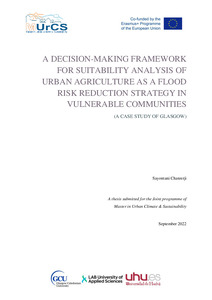A decision-making framework for suitability analysis of urban agriculture as a flood risk reduction strategy in vulnerable communities : a case study of Glasgow
Chateerji, Sayontani (2022)
Chateerji, Sayontani
2022
All rights reserved. This publication is copyrighted. You may download, display and print it for Your own personal use. Commercial use is prohibited.
Julkaisun pysyvä osoite on
https://urn.fi/URN:NBN:fi:amk-2022112824649
https://urn.fi/URN:NBN:fi:amk-2022112824649
Tiivistelmä
Academic study emphasises Urban Agriculture's multifunctionality in its ability to address numerous benefits. However, at a time when natural/green infrastructures are becoming a preferred method of intervention in flood management worldwide, UA's multifunctionality has been limited to its provisional (food, fibre, etc.) or cultural (social participation, community development, etc.) benefits, with little to no research addressing its regulatory services. Many studies discuss the potential of its water management capacities, but little research exists in systematically exploring this, especially when viewed as a flood strategy. The research on the food system, flood risk, and urban agriculture is largely neglected, leaving numerous gaps that impede its applicability to flood management measures in urban areas. Given how flood hazards affect the entire food supply chain, particularly in already vulnerable communities, this relationship is crucial for addressing and evaluating the interconnectivity of rising flood risks and food systems. In the face of a hazard, both vulnerabilities and exposure dictate the extent of impact and therefore this study explores UA’s potential in reducing vulnerabilities at the very heart of the flood-food nexus. To that purpose, this study defines common relationships between the two challenges, investigates their interdependencies in terms of both vulnerabilities and hazards, and proposes a framework for decision-making processes to identify prime intervention areas. Because the importance of urban agriculture and research in the global north is relatively limited, the assessment is carried out in Glasgow, Scotland, a city with high levels of land degradation, flood concerns, and food poverty.
The simulation exercises - conducted using InVEST and geospatial analysis - for the city of Glasgow exhibited substantial enhancements in flood retention and nutrition in the case study area. Thus, highlighting the potential of UA in addressing flood risk and food poverty. These findings, alongside the outcomes of a comprehensive literature review and expert consultation exercises (AHP), paved way for a decision-making framework. The framework is intended for use as a preliminary decision-making tool at the normal level for local governments and flood risk management practitioners while serving as a starting point for further research into UA as a flood risk reduction technique.
The simulation exercises - conducted using InVEST and geospatial analysis - for the city of Glasgow exhibited substantial enhancements in flood retention and nutrition in the case study area. Thus, highlighting the potential of UA in addressing flood risk and food poverty. These findings, alongside the outcomes of a comprehensive literature review and expert consultation exercises (AHP), paved way for a decision-making framework. The framework is intended for use as a preliminary decision-making tool at the normal level for local governments and flood risk management practitioners while serving as a starting point for further research into UA as a flood risk reduction technique.
